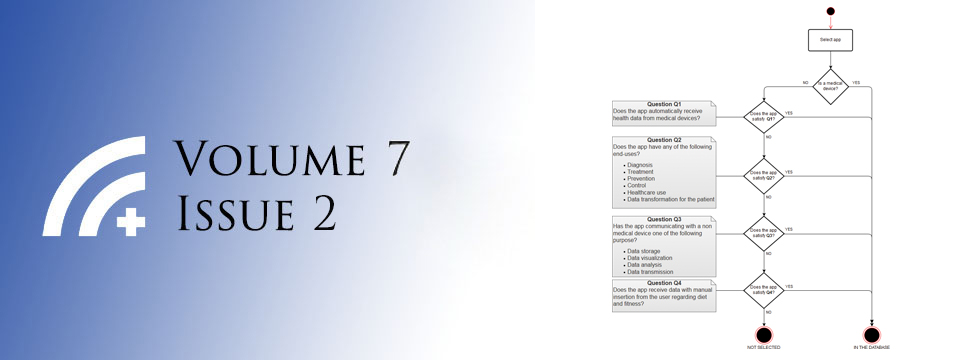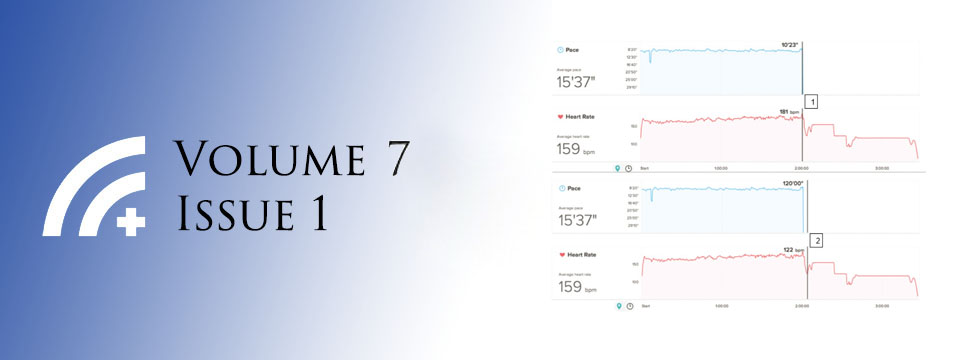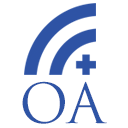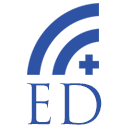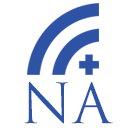Posted on Jul 16, 2015 in Original Article |
Carol E. Smith, PhD, RN1, Ryan Spaulding, PhD2, Ubolrat Piamjariyakul, PhD, RN3, Marilyn Werkowitch, BSN RN4, Donna Macan Yadrich, BS, MPA5, Dedrick Hooper, BS6, Tyson Moore, BSN, RN7, Richard Gilroy, MD8
1School of Nursing and Preventive Medicine & Public Health Department, University of Kansas Medical Center; 2Center for Telemedicine and Telehealth, Interim Associate Vice Chancellor, Institute for Community Engagement, University of Kansas Medical Center; 3School of Nursing, University of Kansas Medical Center; 4School of Nursing, University of Kansas Medical Center; 5Interventionist, School of Nursing, University of Kansas Medical Center; 6Center for Telemedicine and Telehealth, University of Kansas Medical Center; 7School of Nursing, Children’s Mercy Hospital, University of Kansas Medical Center; 8Department of Gastroenterology and Hepatology, University of Kansas Medical Center
Corresponding Author: upiamjariyakul@kumc.edu
Journal MTM 4:2:21–32, 2015
doi:10.7309/jmtm.4.2.4
Background: Patients requiring daily intravenous (IV) home parenteral nutrition (HPN) would benefit from in-home professional observation to improve self-care, to assess, detect and prevent serious complications.
Aims: The study aims are to assess the viability and utility of conducting mobile healthcare (mHealth) videoconference assessments with patients managing lifelong daily 12-hour IV nutrition infusions in their homes. The challenges and solutions to implementing mobile personal computer (PC) tablet based clinic appointments are described.
Methods: A wireless Apple iPad Mini™ mobile touch-screen tablet computer with 5 mega-pixel camera was loaned to patients. Each tablet had Polycom RealPresence software and a fourth generation (4G) mobile telecommunications data plan. These supported audio-visual mobile videoconferencing encrypted connections between health professionals in their offices and HPN patients and their family members in their homes. Patients’ and professionals’ evaluations of their mHealth clinic experiences are collected.
Results: Patients (mean age = 41.9, SD = 2.8 years) had been prescribed 12-hour home parenteral nutrition (HPN) infusions daily due short bowel disorders. Patients had been on HPN from 1 to 10 years (M = 4, SD = 3.6). Evaluation of clinic appointments revealed that 100% of the patients (n = 45) and the professionals (n = 6) indicated that they can clearly hear and easily see one another. The mHealth audio-visual interactions were highly rated by patients and family members. Professionals highly rated their ability to obtain a medical history and visual inspection of patients. Several challenges were identified and recommendations for resolutions are described.
Discussion: All patients and professionals highly rated the iPad mHealth clinic appointments for convenience and ease of communicating between homes and offices. An important challenge for all mHealth visits is the clinical professional’s ability to make clinically accurate judgments about what they observed and heard from the patients. Following our solutions for obtaining clear visuals with the iPad can improve ability to make clinical assessments.
Posted on Jul 16, 2015 in Original Article |
Nuananong Seal, Ph.D., RN1, Oluwatoyin Olukotun, BSN, RN1
1University of Wisconsin-Milwaukee
Correspondence Author: nseal@uwm.edu
Journal MTM 4:2:12–20, 2015
doi:10.7309/jmtm.4.2.3
Background: Smartphone technology is the fastest growing in U.S. populations particularly in African -American community. Smartphone technology, therefore, may hold promise for improving health communication and accuracy of dietary intake assessment in this population. There is no information about maternal perceptions of using smartphone for dietary assessment. This paper reports the perceptions of low-income African -American mothers of children aged four to five years towards the use of smartphone for their children’s dietary intake assessment and as a means of receiving nutritional feedback.
Methods: A total of 17 low-income African -American mothers, who attended a large food pantry community center in Wisconsin and were eligible to participate in the study, completed either focus group discussions or individual interviews. The mothers also completed a self-administered demographic and smartphone activity patterns survey. The mothers who were interested in taking a photograph of a meal of their child were provided a private email address for sending the photographs to the researcher using their smartphones.
Results: The focus group and interview data were analyzed using thematic and structural analysis techniques. Mothers’ mean age was 37 years (range 23-48 years) with mean BMI at 33 (range 23-40). Children’s mean age was 4.8 years (range 4-5.6 years). Children’s mean BMI percentile was at the 92nd percentile (range 82nd – 96th percentile). These mothers seemed to have favorable attitudes towards the use of smartphones to take photographs of their children’s diets and receive nutritional feedback for their children.
Conclusion: The mothers in this study have a strong interest in using their smartphones to assess their children’s diets and download mobile health apps i.e. healthy recipes, and receive nutritional feedback for their children’s diets via SMS. Smartphone technology appears to hold great potential in terms of accurate, efficient, user-friendly, and flexible features in helping these low-income African-American mothers and health care providers to assess children’s dietary intake. Further studies testing the acceptability of mobile-based health apps in low-income African-American mothers and its effects on their children’s healthy body weight and nutritional well-being are warranted.
Posted on Jul 16, 2015 in Original Article |
William H. Spires, Pharm.D., M.B.A.1, Amber Wesner, Pharm. D., BCPS1, Robert S. Kidd, Pharm.D., Ph.D.1
1Department of Pharmacy Practice (AR Wesner) and Department of Biopharmaceutical Sciences (RS Kidd) Shenandoah University, Winchester, Virginia. From the Bernard J. Dunn School of Pharmacy (WH Spires) Shenandoah University, Winchester, Virginia
Corresponding Author: rkidd@su.edu
Journal MTM 4:2:2–11, 2015
doi:10.7309/jmtm.4.2.2
Background: Due to changes in treatment guidelines, traditional pharmacokinetic based dosing and existing vancomycin nomograms may not predict doses adequate for reaching the increased trough concentration goals. A novel nomogram was created to achieve the updated goals, and the nomogram was previously validated at our institution. For this study, the nomogram was converted into an iOS vancomycin clinical decision support software (CDSS) application.
Aims: This study was designed to determine if the use of the iOS vancomycin CDSS application decreases the time pharmacists spend dosing vancomycin thus resulting in a cost savings to the health-system.
Methods: Enrolled patients’ dosing regimens were determined using the newly developed iOS vancomycin CDSS application. Survey data was used to assess pharmacists’ impressions of the iOS vancomycin CDSS application and the time required to determine a personalized vancomycin dosing regimen among several different dosing methods. The accuracy of the iOS vancomycin CDSS application was also evaluated and compared to data from the original paper version of the dosing nomogram.
Results: A total of 367 patients were dosed using the iOS vancomycin CDSS application, and 146 of these patients met all inclusion criteria for accuracy analysis. The mean time savings of using the iOS vancomycin CDSS application versus traditional pharmacokinetic calculations was 10.3 minutes per consult (p = 0.014). The iOS vancomycin CDSS application was estimated to save a total $13,617 per year compared to using traditional vancomycin pharmacokinetic calculations at our institution. There was no statistical difference in therapeutic trough concentration frequencies between the paper nomogram and the iOS vancomycin CDSS application (p =0.877).
Conclusion: An iOS vancomycin CDSS application saved pharmacist’s time, established a moderate cost-savings, was well accepted, and accurately predicted appropriate vancomycin dosing regimens. This iOS CDSS drug dosing application was only used for vancomycin, and therefore the time and costs savings could increase substantially as more drugs are incorporated into the CDSS application.
Posted on Jul 15, 2015 in Editorial |
Rahul Chakrabarti
Journal MTM 4:2:1, 2015
doi:10.7309/jmtm.4.2.1
Dear readers,
It is with great pleasure that we present the second issue of the Journal for the year. The current issue highlights excellent examples of the capacity for translational research in mobile health. Fundamentally, the concept of translational research refers to the evolution of “bench to bedside” care. In the past the concept has referred to the application of knowledge attained through basic science research to improving clinical outcomes for patients. In this context, mobile technologies such as smartphones and tablet devices with their increasing accessibility and user-friendly interfaces have a great potential to demonstrate clinical benefits.
Smith et al demonstrate the ability of mobile technologies to improve quality of care through facilitating clinician-patient interaction. In their proof-of-concept study, the authors demonstrate that barriers to clinician-patient interactions can be overcome with video-conferencing using tablet devices. Using the example of patients with short bowel disorders receiving home parenteral nutrition, the authors demonstrated that home-based video conferencing was feasible, and received well by patients and their families in the daily management of chronic disease. Furthermore, the scheduled videoconferences provided an out-of-hospital forum for clinicians to monitor the symptoms, clinical parameters, and examine potential clinical risks including intravenous line sites for infection. Whilst the authors acknowledged obvious limitations of internet connectivity and privacy, overall the study showed that this modality of clinical interaction clearly has a role for chronic disease management. This particularly poignant to the management of conditions whereby patients often have prolonged intervals between scheduled hospital outpatient follow-up during which potentially avoidable complications occur necessitating hospitalization.
Over the past half decade, governments and health policy makers have mandated the imperative for research institutes to focus on translational research. The United Kingdom has invested 5 billion Pounds to establish translational research centres, mirroring 6 billion Euro by the European Commission for translation health research.1 Mobile technologies stand at the forefront of effective translation of the application of novel devices to facilitate and enhance patient care. As demonstrated in the current issue, the applications of translation research in mHealth are varied and diverse. Continued engagement of commercial, government and private stakeholders are required to keep up the momentum in ensuring these technologies are safe, reliable, accessible and affordable, particularly to those in low-resource settings, where the greatest growth potential rests. Only then will we have realized the potential of translational research in mobile health.
References
1. Woolf SH. The meaning of translational research and why it matters. Jama 2008;299(2):211–13. 
Posted on Jun 26, 2015 in News |
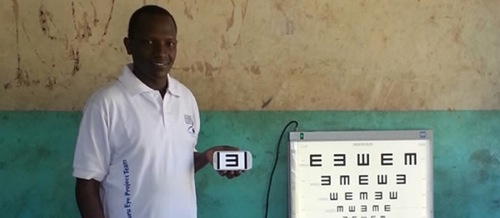
Results from a recent study published in JAMA Ophthalmology, have shown that the Peek (Portable Eye Examination Kit) Acuity app is just as accurate as ETDRS and Snellen chart for testing visual acuity. This makes the app one of the few mobile health applications to be proven and validated in a clinical trial.
The app was tested on 233 Kenyan adults aged 55 and above. The results were found to be just as accurate and repeatable as the Snellen chart, while being comparable in accuracy to the ETDRS chart.
In developing countries where access to specialist clinics are limited, the Peek Acuity app enables healthcare and community workers to test visual acuity using an accurate and portable system in the patient’s home or in clinic. Lead author of the study and co-founder of the Peek Acuity app, Dr Andrew Bastawrous said, “we aimed to develop and validate a smartphone-based visual acuity test which would work in challenging circumstances, such as rural Africa, but also provide reliable enough results to use in routine clinical practice in well-established healthcare systems.“
The app features a “tumbling E”, where the letter E is displayed in 1 of 4 orientations. The patient points in the direction they perceive the arm of the letter E to be pointing. The use of the “tumbling E” allows eye tests to be performed on those unable to read letters used in the English language, and ensures acuity is resolution based rather than recognition based. The application also provides alternatives to finger counting, hand movements and light perception.
Peek Acuity app is currently compatible with Android and iOS devices.
By: Dr Joanne Teong
Source: http://www.peekvision.org
Link to study: JAMA Ophthalmology
Posted on Apr 8, 2015 in News |
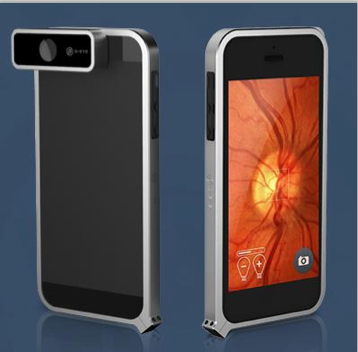
The D-EYE Retinal Imaging System is an innovative device that converts a smartphone into a portable, easy-to-use, affordable, and effective fundus camera.
The D-EYE device is a smartphone-sized case that fits onto an Apple iOS or Android phone. The D-EYE fundoscope lens is positioned over the smartphone’s camera and LED light source, enabling the phone to capture high definition video and still images of the fundus of the eye. The D-EYE app installed on the smartphone allows the user to store and manage patient information.
The D-EYE Retinal Imaging System offers:
- Field of view up to 20 degrees
- Easy viewing of optic nerve head, even without dilating eye drops, for detecting glaucoma
- Diabetic retinopathy screening and grading
- Hypertensive retinopathy screening and grading
- Age-related macular degeneration screening
- Cataract diagnosis and grading
- Visual acuity testing for adults and children
- Ability to record multiple images or videos
- Optional private and secure cloud-based storage system
- No additional external power or lighting source required
The D-EYE Retinal Imaging System was invented by Dr Andrea Russo to improve accessibility to medical screenings for people in need. The convenience and portability of the device is especially valuable for examining bed-ridden patients, children and infants. According to Dr Russo, “The D-EYE retinal screening system can be used by a variety of health professionals ranging from ophthalmologists, neurologists, general practitioners, emergency physicians and pediatricians, to school nurses and others. The system offers a quick, accurate and inexpensive way to examine the human eye and identify a variety of health conditions.”
The D-EYE Retinal Imaging System is currently compatible with iPhone 5, 5S, and 6, or Samsung Galaxy S4 and S5.
Source: http://www.d-eyecare.com
By: Dr Joanne Teong

